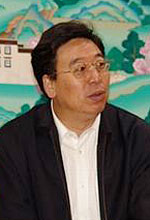|
This year marks the 50th anniversary of the beginning of democratic reform in China's Tibet Autonomous Region. Wu Yingjie, Executive Vice Chairman of the Tibet Autonomous Region, recently talked to Beijing Review reporter Liu Yunyun about its past achievements and future challenges.
 |
|
Wu Yingjie, Executive Vice Chairman of Tibet Autonomous Region (JIANG XIAOYING) |
Beijing Review: You have stayed in Tibet for almost 35 years. Tell us how Tibet has developed over that time from your perspective?
Wu Yingjie: Local people often say the old Tibet (before 1959) and the new Tibet (after 1959) are the difference between hell and heaven. For my part, I have observed a sea change in the past 35 years both in terms of economic development and social improvement.
Over the past five decades, the Central Government has invested heavily in Tibet. More than 100 billion yuan ($14.6 billion) from the central budget has been appropriated for infrastructure construction in Tibet. From 2005 to 2010 alone, the government will invest an additional 70 billion yuan ($10 billion) for 180 projects in the region, including a railway from Lhasa to Xigaze. All those projects are meant to improve the quality of local people's lives.
Tibet has seen remarkable economic development. Since 1994, the region's economy has been growing at double-digit speed, and year-on-year gross domestic product grew 10.1 percent in 2008, defying the global economic downturn.
Tibet also enjoys favorable policies to which other provinces are not entitled. For instance, all the highways in Tibet are toll-free-unimaginable for inland drivers. As early as the 1980s, local farmers and herdsmen were exempt from agricultural taxes, whereas in the inland cities, the same policy was adopted in 2007. Tibetans are also exempt from the "one-child" policy, and they can have as many children as they want.
In terms of education, Tibetan students have not had to pay tuition fees since 1980, and schools provide free accommodations and clothes for boarding students from farming and herding families. Few inland students are this lucky.
Each year, the Central Government spends about 3 billion yuan ($439 million) to support education in Tibet. In old Tibet on the other hand, over 90 percent of the population were illiterate. Average people didn't have the right to go to school. But now, all Tibetan children can get an education at the schools nearest to them.
What have the regional and central governments done to protect Tibetan culture and history?
Thanks to the work of our cultural protection departments both at local and central levels, Tibetan folk art and stories that were in danger of extinction have been saved.
By the end of last year, we had recorded folk arts and songs in more than 500 videotapes and 1,000 audio cassettes archiving local arts and songs.
The regional government is sparing no effort in preserving the Tibetan language. In primary and high schools, Tibetan is the most commonly used language, both in teaching and in textbooks.
The Central Government has been picking up momentum in protecting the remaining historical sites.
During the last two decades of the 20th century, the government invested more than 300 million yuan ($44 million) to repair monasteries and lamaseries like Jokhang Temple and Tashihunpo Monastery. So far this century, the Central Government has invested nearly 1 billion yuan ($146 million) in revamping 25 cultural relics in Tibet.
What does the local government do to protect freedom of religious belief in Tibet?
The Central Government adheres unswervingly to the freedom of religious belief written in the Constitution.
In Lhasa, on the fifth, 10th and 15th days of each month on the Tibetan calendar, the whole city is full of incense and nobody interferes with the devoted pilgrims. Each day, there are thousands of people walking around the Potala Palace. And they stay there as long as they want. No one would turn them away.
Some pilgrims travel all the way from Qinghai Province to Lhasa to see this holy city. When they run out of money, the government pays to send them home.
Currently, Tibetan Buddhism has been growing in influence, especially in inland cities. After people experience a measure of economic prosperity, they start to seek inner comfort from Buddhism. No interference is imposed on those new followers.
If these examples do not prove we respect religious freedom, then I have no idea which country can do better.
What problems beset Tibet's development?
Environmental protection is our greatest concern. We don't tolerate economic development where we must make environmental sacrifices. Any projects that potentially threaten the environment cannot get a nod from the government.
Then, other problems surface. The region is rich in mining resources like copper, lead and zinc. To make use of those resources, we would have to dynamite the mountains, many of which are worshipped by Tibetan residents as sacred places. We respect their beliefs; consequently, we have not yet begun to exploit those resources. Likewise, we have hardly made use of the region's rich water resources.
Meanwhile, global warming exerts serious impacts on the plateau, which is called a "snow-capped land." The warming climate is increasingly devouring the plateau's glaciers while higher evaporation threatens downstream regions with water shortages. Snow has hardly fallen on this plateau in recent years, posing a daunting challenge to scientists. This problem needs to be tackled as soon as possible. | 